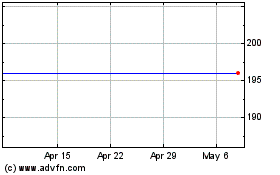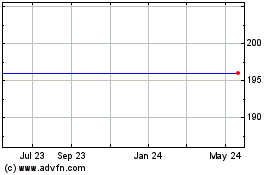By Jay Greene and Anne Steele
Microsoft Corp., in what is by far the biggest acquisition in
the company's history, said Monday it had reached a deal to buy
LinkedIn Corp., the professional social-networking company, for
$26.2 billion in cash.
Integrating Microsoft's and LinkedIn's offerings would broaden
their reach, enhance their utility, and create market-leading
services for business customers, the companies said. Microsoft will
pay $196 per LinkedIn share, a 50% premium to LinkedIn's closing
price on Friday.
Shares of LinkedIn, which had dropped 42% so far this year
through Friday's close, jumped 47% to $192.46. Microsoft shares
fell 2.9%.
Microsoft said LinkedIn will "retain its distinct brand, culture
and independence," with Chief Executive Jeff Weiner remaining at
the helm, reporting to Microsoft CEO Satya Nadella. The deal, the
largest acquisition ever for Microsoft, is expected to close within
the year.
The companies see cost savings of about $150 million a year by
2018. LinkedIn would be required to pay a $725 million breakup fee
if it backs out of the deal.
Microsoft believes the acquisition will expand the market for
both LinkedIn and Microsoft's Office products. The software giant
has made a significant push in the past few years to make its
products more connected and wants to use data to make them more
intelligent. LinkedIn's vast network offers data that could
help.
Microsoft may find ways to generate revenue from LinkedIn's
professional network that LinkedIn couldn't independently, said
Stifel Nicolaus & Co. analyst Brad Reback.
Connecting LinkedIn directly to Office could help attendees of
meetings learn more about one another directly from invitations in
their calendars. Sales representatives could pick up useful tidbits
of background on potential customers from LinkedIn data.
Microsoft is betting that the combination of Microsoft and
LinkedIn services will make workers more productive by revealing
connections and data that might otherwise take additional steps to
find. That could increase the value of Office to customers, and
helps explain why Microsoft made the deal.
"They are paying a full price, but they are not paying an
egregious price," Reback said. "It's worth the bet."
Mr. Nadella said in an interview that "work today is split"
between tools such as Microsoft's Office programs workers use to
get their jobs done and professional networks that connect workers.
The deal, he said, aims to weave those two pieces together.
"It's really the coming together of the professional cloud and
the professional network," Mr. Nadella said.
For LinkedIn, the deal will expand its ability to sell products.
The company, for example, bought online training video service
Lynda.com for $1.5 billion last year. Now, it will be able to offer
Lynda's videos inside Microsoft's products, such as its Excel
spreadsheet application.
In a memo to employees, Mr. Nadella said the combination will
enable features like a LinkedIn feed that "serves up articles based
on the project you are working on and Office suggesting an expert
to connect with via LinkedIn to help with a task you're trying to
complete."
As the LinkedIn and Office engagement grows, "new opportunities
will be created for monetization," Mr. Nadella said.
Mr. Weiner, in a letter to employees posted online, said the
acquisition would help LinkedIn weather intensifying competition in
the tech landscape.
"Imagine a world where we're no longer looking up at tech titans
such as Apple, Google, Microsoft, Amazon and Facebook and wondering
what it would be like to operate at their extraordinary scale --
because we're one of them," Mr. Weiner said. Mr. Weiner said
"little is expected to change" for most LinkedIn employees.
Microsoft said it expects LinkedIn, which will be part of its
productivity and business-processes segment, will have a minimal
negative impact -- about 1% -- on adjusted earnings for its fiscal
2017 and 2018 years. The deal is expected to add to Microsoft's
per-share earnings in 2019.
LinkedIn went public in May 2011 at $45 a share in the biggest
internet IPO since Google Inc.'s debut in 2004, and its stock more
than doubled on its first day of trading. Shares peaked around $270
in February 2015 but have since lost about half their value as the
company forecast a much weaker-than-expected 2016 as it shifts
gears on its advertising strategy.
About two-thirds of LinkedIn's revenue comes from its
talent-solutions division, which helps corporate recruiters
identify job candidates, in contrast to other social networks that
primarily rely on advertising revenue. The unit generated $558
million in revenue in the first quarter, up 41% from a year
ago.
Microsoft has made a number of big acquisitions in recent years.
Among them was its problematic $9.4 billion purchase of Nokia
Corp.'s mobile phone business, most of which has been written off.
The company also spent $8.5 billion in 2011 to buy Skype SARL, the
provider of video and voice chats, and $2.5 billion in 2014 for
Mojang AB, the maker of the "Minecraft" videogame.
A rare tech stalwart that has appeared to be making a deft
transition to the new world of web-based, on-demand computing,
Microsoft faltered in its latest quarter as the growth of its cloud
business slowed.
LinkedIn reported $2.99 billion in revenue for 2015, a 35%
increase from a year earlier, while its loss widened to $164.8
million from $15.3 million on a surge in costs related to sales and
marketing and product development.
Write to Anne Steele at Anne.Steele@wsj.com
(END) Dow Jones Newswires
June 13, 2016 12:45 ET (16:45 GMT)
Copyright (c) 2016 Dow Jones & Company, Inc.
Linkedin Corp. Class A (NYSE:LNKD)
Historical Stock Chart
From May 2024 to Jun 2024

Linkedin Corp. Class A (NYSE:LNKD)
Historical Stock Chart
From Jun 2023 to Jun 2024
